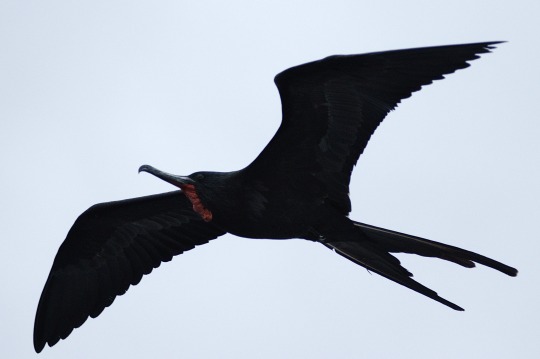#Galapagos Islands
Explore tagged Tumblr posts
Text




Roccella nigerrima
Why are there so few pictures of this lichen on the internet? Well maybe because it is only found on the Galapagos Islands, and when people go to the Galapagos, they're not usually there to take pictures of the lichens, unfortunately. But like, how could you not want to take pictures of this beautiful little critter? This fruticose lichen has pale white-gray, terete, many-branched thallus, and grows on costal rocks and cliffs. It produces ochre to pale brown soredia along the lower branches, and has only been found with apothecia on one occasion. There are 2 very similar Roccella species native to South America, but they both have a C+ reaction whereas R. nigerrima here has a C- reaction. So you know, if you are ever traveling in the Galapagos and happen to have some bleach on you for chemical testing of lichens and are able to ID this little guy, definitely snap some pictures! For me, for yourself, and for the lichenology community at large.
images: source | source | source
info: source
#lichen#lichens#lichenologist#lichenology#mycology#ecology#biology#fungi#fungus#nature#galapagos#Galapagos Islands#the natural world#beautiful nature#weird nature#symbiosis#symbiotic organisms#algae#Roccella nigerrima#Roccella#I'm lichen it#lichen a day#daily lichen post#lichen subscribe#life science#environmental science#natural science#go outside#take a hike#look for lichens
780 notes
·
View notes
Text

Article
"2023 was a banner year for the Galapagos Islands: that wondrous archipelago so famous for its giant tortoises and other endemic species.
The long-serving conservation organization the Galapagos Conservancy, also endemic to the islands, recently published its annual report featuring standout figures like over 500 giant tortoises of 5 different species reintroduced to their natural habitat.
Additionally, a critically endangered species of albatross was identified to use giant tortoise feeding sites as take-off and landing areas. This key insight into co-dependency has given the Conservancy confidence that they can restore the populations of both animals to stable, flourishing numbers.
It underscores how far a donation to these endemic wildlife organizations really does go, and these two highlights of a successful year were only possible by the over $6 million in charitable contributions from supporters.
30 Chelonoidis chatamensis tortoises endemic to the smaller island of San Cristobal were repatriated to their natural habitat from the stock of a captive breeding program, while 97 native tortoises were returned to the second-largest island of Santa Cruz.
On the largest island of Isabella, 350 tortoises (214 C. guntheri and 136 C. vicina) were successfully reintroduced to their natural habitat after a survey found their numbers were not rising substantially on their own.
In March, the repatriation of 86 juvenile Chelonoidis hoodensis tortoises significantly contributed to enhancing the species’ distribution across their native habitat. They currently number 3,000 today on Española or Hood Island, a miraculous recovery from the 14 found there in the 1960s.
Also on Española, the endemic waved albatross was found to be taking off and landing on 50 additional parts of the island. These large birds, boasting an 8-foot wingspan, need ample space to get a running start before taking off, and this same principle applies when applying the brakes coming down from the sky.
In the survey, the biologists observed that concentrations of giant tortoises were linked with the usage of areas as runways for the albatross. Because the tortoises are the largest herbivores in the ecosystem, they perform the same acts as bison do in North America and Europe, and elephants in Africa—clear space.
With their herbivorous diet and large bulk, the tortoise’s feeding habits produce cleared areas ideal for albatross use.
“This discovery underscores the interconnectedness of the Galápagos ecosystem,” the authors of the report write. “This newly acquired knowledge allows us to strengthen the synergies between our conservation strategies.”
Of the $6.1 million received from donations and through other activities, the Conservancy was able to spend 77% of that on conservation programs, and that included some ambitious plans for this year—now already half done—which included drafting plans for restoration of the Pinta tortoise to the island of the same name, preparing tortoises for imminent reintroduction to the smaller Floreana island, and completely restoring the habitat for the Galapagos petrels on Santa Cruz.
Operating since 1985, the Galapagos Conservancy has a long track record of restoring these islands to their pre-Colombian glory. Let’s hope 2024 is as successful."
-via Good News Network, July 19, 2024
#galapagos#tortoise#galapagos islands#conservation#biodiversity#albatross#reptile#reptiblr#endangered species#wildlife conservation#ecosystems#climate action#conservation news#good news#hope
566 notes
·
View notes
Text

Preening is a common mating and bonding ritual between mated birds. It serves as a way to erode their normal spatial instincts to attack or avoid another animal in close range
(Nazca boobies)
#photography#art#outdoors#nature#animals#digital art#wildlife#adventure#birds#outdoor#galapagosexpeditionann#galapagos islands#galapagos#travel#travelphotography
807 notes
·
View notes
Text

Galápagos Islands
A school of brightly colored cardinalfish darting from the path of a Galápagos sea lion.
PHOTOGRAPH BY CRISTINA MITTERMEIER
#cristina mittermeier#photographer#galapagos islands#cardinalfish#marine photography#fish#galapagos sea lion#sea lion#animal#mammal#wildlife#nature#national geographic
78 notes
·
View notes
Photo

A crevice made from volcanic stone, a home base for several tintoreras sharks peacefully resting during the day. Galapagos Islands, Ecuador
981 notes
·
View notes
Text

Turtle Tortuga, Galapagos Islands, Ecuador: The Galápagos Islands are an archipelago of volcanic islands in the Eastern Pacific, located around the Equator 900 km west of South America. They form the Galápagos Province of the Republic of Ecuador. The province is divided into the cantons of San Cristóbal, Santa Cruz, and Isabela, the three most populated islands in the chain. The Galápagos are famous for their large number of endemic species, which were studied by Charles Darwin in the 1830s and inspired his theory of evolution by means of natural selection. All of these islands are protected as part of Ecuador's Galápagos National Park and Marine Reserve. Wikipedia
102 notes
·
View notes
Text

Galápagos Giant Tortoise (Chelonoidis nigra), family Testudinidae, Galapagos Islands, Ecuador
This species is the largest terrestrial reptile in the world.
photograph by wapiti8 | Flickr
#tortoise#turtle#chelonoidis#testudinidae#reptile#herpetology#galapagos islands#south america#animals#nature
239 notes
·
View notes
Text
Some gorgeous super 8mm film home movies (Galapagos islands late 60s? ) shot by the late Norma Mastin. Mastin was a teacher and lifelong, passionate photographer. Last year I picked up a collection of her home movies which documented her lengthy travel all over the globe spanning many decades. There’s a LOT to go through. But this was a beautiful start. Great color. Shot in a thoughtful, professional way.
151 notes
·
View notes
Photo

HMS Surprise
263 notes
·
View notes
Text

Galapagos Islands
7 notes
·
View notes
Text
Please reblog for a bigger sample size!
If you have any fun fact about Galápagos Islands, please tell us and I'll reblog it!
Be respectful in your comments. You can criticize a government without offending its people.
48 notes
·
View notes
Text

A scene from the Galapagos.
#vintage illustration#galapagos#galapagos islands#charles darwin#darwin#darwinism#science#biology#zoology#evolution#natural history#marine biology#taxonomy#evolutionary biology#evolutionary theory#biogeography
14 notes
·
View notes
Text

Pure magic in the Galápagos Islands!
Props to Trip Leader Davide Oggionni for capturing it 🐬
#Davide Oggionni#Pure magic#Galapagos Islands#Dolphins#Amazing#Ocean Life#Beautiful#Nature#Photography
15 notes
·
View notes
Text

Frigatebirds large wingspan (2 meters or 7 feet) allows them to fly for weeks at a time.
(Frigatebird)
#photography#art#outdoors#nature#digital art#animals#wildlife#adventure#outdoor#birds#galapagos islands#galapagosexpeditionann#galapagos#travel#travelphotography
402 notes
·
View notes
Text

A green sea turtle, thought to be one of the few turtle species that nest on the Galápagos islands, rests on colorful volcanic rock.
Tom Shlesinger, Ecuador, 2021
#tom schlesinger#photographer#ecuador#green sea turtle#turtle#reptile#animal#nature#galapagos islands
28 notes
·
View notes
Text




Bucket List:
Visit the Galápagos Islands
#Galapagos#travel#Galapagos islands#nature#wildlife#my bucket list#bucket list#Clare’s bucket list#islands#animals
2 notes
·
View notes